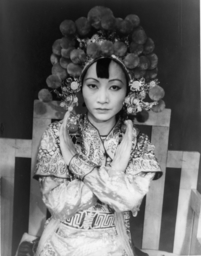Anne Anlin Cheng’s latest book Ornamentalism, released back in 2019, is arguably the first sustained theory of Asiatic feminism and is undoubtedly an important addition to critical race studies.
‘Celestial Lady, Lotus Blossom, … Geisha, Concubine, Butterfly, China Doll, Prostitute.’ The figure Cheng interrogates is familiar to all of us: the highly adorned Asian woman (a specific country of origin often foregone) as she has appeared in European portraiture, through to the image of 20th-century superstar Anna Mae Wong, right up to the more sophisticated figure of desire played by Maggie Cheung in In the Mood for Love (2000).

For Cheng, this striking ornamentation is so ubiquitous, it is an integral part of the ‘skin’ of this figure. Her book, then, seeks to explore the relationships and conflations between objects and persons.
Discussion of black bodies often foregrounds the harmful processes through which a person becomes an object, the most extreme example of course being slavery. What Cheng suggests is that for Critical Race Theory to develop, and she very astutely demonstrates the relevance here for all non-white races, we must begin to consider a more nuanced exploration of when an object stands in for a person. (To illustrate this idea in its most exaggerated form, I’d suggest searching ‘Li Xiaofeng’ on Google Images, as we are unfortunately unable to reproduce the image on Her Campus. The artist creates these unique, highly sculptural works of fashion which explore the West’s relationship to porcelain.)
We must ‘substitute ornament for flesh’, Cheng insists, in discussing skins that ‘never enjoyed the fantasy of organicity’.

It is Cheng’s attitude that making people uncomfortable is a crucial part of developing these important conversations. Indeed, the book opens with this statement:
‘We say black women, brown women, white women, but not yellow women.’
The author is not hoping to reclaim the term ‘yellow woman’ for politically defiant means, but rather aims to insist on drawing attention to our own cultural ‘queasiness’ when confronting this figure whose elaborate representation often paradoxically results in invisibility and absence.
Notably, Cheng also joins an increasing number of academics and activists rejecting the term ‘women of colour’, criticising its lack of nuance. Furthermore, Cheng suggests that privileges of injury mean that when ‘women of colour’ is used, it is often with a central focus on black women, a flaw also identified by Kimberlé Crenshaw, the legal scholar who coined the term ‘intersectionality’.
(‘Is the yellow woman injured – or is she injured enough?’, Cheng suggests is a question we are continually asking.)

However, issues of intersectionality are consistently explored throughout, and Cheng is mindful of possible relevancies for black personhood and white femininity, demonstrating the complex relationships between the unique but not necessarily siloed issues that these identities encounter.
There is no shying away from the fact that this is an academic book, and the introductory chapter certainly is not light or easy reading. However, not only do I believe this book to be an important text, but also a thoroughly interesting one, replete with fascinating anecdotes and insights into numerous topics which make the work tremendously readable. Fashion, literature, cinema, contortionism, mermaids, legal battles, sushi… all these and more are covered in Cheng’s tremendously rich interdisciplinary approach.
Starting with the fascinating and underexplored Chy Lung v. Freeman case of 1875, which had tremendous repercussions on US citizenship laws, Cheng goes on a chronological journey that takes the reader right the way up to critiques of contemporary films that have provoked much conversation: Ex Machina (2014), Get Out (2017), and Ghost in the Shell (2017).

Although the ideas can be complex, Cheng is also a masterful writer who carefully navigates potentially murky territory with tremendous precision, keeping her work straightforward. That is not to say she does not indulge in the absurd nomenclature of academic writing. Indeed, in the discussion of a surreal short story that involves a third-wheeling sea-mammal, Cheng’s delightful transition from ‘Otherness’ to ‘Otterness’ will surely leave readers grinning.
For those who do not often read non-fiction texts and are still not convinced, I wish to highlight a prime example of the fascinating (and at times, incredulous) history that Cheng is exploring: the Chy Lung v. Freeman case.
In August 1874, six-hundred passengers arrive in San Francisco from Hong Kong on the SS Japan. All but twenty-two young women are allowed to disembark. Although they possess the correct papers and had the right to enter under the 1868 Burlingame Treaty, the women are travelling unaccompanied (by men) and arouse suspicion. Their detainment sparks wide media coverage.
What Cheng is most interested in is that when, ultimately, a group of white American men are brought together to discuss this case, their conversation is unexpectedly dominated by discussions of what Chinese women might wear. Colour, patterns, textures, cuts. It is one of those bizarre moments in history that one cannot make up, especially considering that the women’s attire did not even remotely resemble the clothing being described.

I truly believe this to be an important, must-read text that will only grow in stature in the coming years. Anne Anlin Cheng writes and reveals with brilliance, and her analyses are never far-fetched or convoluted, but are always insightful, relevant, and revelatory. Indeed, if a reader with a habit of underlining in pencil opened this tome, they might quickly find the whole book illegible for scores of graphite, which would be a shame as this is also such a beautifully presented text.
Given that this is largely a visual history being explored, the book is generously filled with arresting colour images, including a multitude of dresses that featured in the Metropolitan Museum of Art’s popular yet controversial 2015 exhibit China: Through the Looking-Glass. Of course, these images not only illustrate the discussion but also afford pleasure for the reader, which perhaps highlights our own continued and problematic fascination with Western Orientalism.
***
All quotes in this article are taken from Anne Anlin Cheng’s Ornamentalism (OUP, 2019). A copy can be bought direct from the publisher here.



